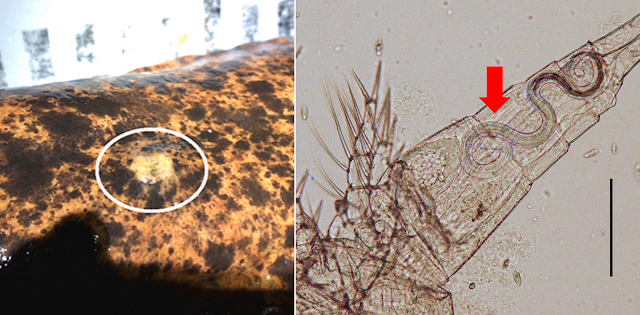Floating amidst the ocean's plankton is a tiny monster, it has no mouth and it must mate, after which it will give birth to a new generation of little monsters that will grow within the bodies of worms. Everything about this tiny crustacean sounds like a science fiction monster, starting with the group's name - Monstrilloida, meaning "tiny monster" - coined by a scientist who found their life cycle and appearance to be delightfully bizarre.
 |
| Left: Copepodid stage of a female Cymbasoma dissected from a Haplosyllis worm, Right: Adult stage of a female Cymbasoma Photos from Fig. 2 and Fig. 4 of the paper |
Adult monstrilloid are free-swimming and they don't feed, but as juveniles, they live as parasites that can grow inside various marine invertebrates including snails, mussels, and polychaete worms. In polychaete worms, they can grow pretty large in relation to their host, and when they reach adulthood, they bust out of the host like it's a novelty birthday cake. In that way, their life cycles are comparable to the hairworms that parasitise crickets and mantids.
Unlike other planktonic copepods that often swim by flicking their long antennae, the antennae of adult monstrilloids are fixed, so instead they have powerful swimming legs that allow them to kick their way through the water. And while the adult stage of these weird little crustaceans are sometimes found in plankton trawl samples, their juvenile stage are much more elusive. Out of the 195 known species of monstrilloids the parasitic juvenile stage has only been identified for seven species, since they are hidden away in the bodies of their hosts. As a result, it has been over a century since anyone has investigated those parasitic juveniles in detail.
In this study, scientists in Japan were examining pieces of sponge that had been washed up on Tancha Beach at Okinawa Island. Those sponges turned out to be home for hundreds of Haplosyllis polychaete worms, but the worms themselves were also occupied by monstrilloids. This was also the case for sponge worms from Diamond Beach on another part of the island, which turned out to be an absolute haven for the little monsters, with over half of the worms hosting monstrilloids. This abundance of monstrilloids at Okinawa Island presented an amazing opportunity for scientists to get a better look at the parasitic stage of these copepods.
In order to find out more about these enigmatic crustaceans, scientists first had to coax the host worms out of their spongey home, and they did that by taking chunks of the sponges and kept them in water without aeration. As oxygen level dropped, the worms were forced to abandon their sponge to seek more oxygenated water, at which point they could be collected and examined under the microscope. Monstrilloids are relatively large and highly visible as the bulk of the copepod stretches out the worm's body wall to transparency.
Among these sponge-dwelling polychaete worms, the scientists found the larvae of two monstrilloid genera - Cymbasoma and Monstrilla, the former is coloured pale pink while the latter is teal green, but only the female copepods are so eye-catching due to their ovaries. The males are colourless and transparent. These larvae also live up to the monstrilloid name - they are banana-shaped, with a single eye, enclosed in a translucent sheath, and have a pair of long feeding tubes which it uses to slurp up nutrients from the host's body. When they reach maturity, the copepod uses those same tubes to make its exit by tearing a hole through the worm's body wall. Once free of the host's body, the monstrilloid shrugs off its juvenile exoskeleton to transform into an adult and takes its place among the zooplankton.
In order to complete its life cycle, monstrilloids have to survive in three very different environments - the open ocean as adults, the sea floor (briefly) as nauplii, and inside the body of animals as juveniles. In the words of one of the scientists who study these little monsters, they are simply an awesome group of crustaceans.
Reference:







.png)


.png)